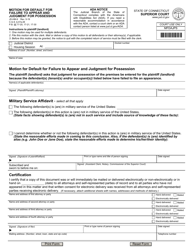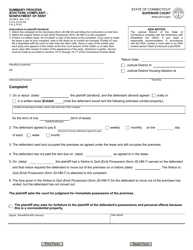This version of the form is not currently in use and is provided for reference only. Download this version of
Form JD-HM-2
for the current year.
Form JD-HM-2 Summary Process Execution for Possession (Eviction) - Connecticut
What Is Form JD-HM-2?
This is a legal form that was released by the Connecticut Superior Court - a government authority operating within Connecticut. As of today, no separate filing guidelines for the form are provided by the issuing department.
FAQ
Q: What is Form JD-HM-2?
A: Form JD-HM-2 is a Summary Process Execution for Possession (Eviction) form in Connecticut.
Q: What is Summary Process Execution for Possession?
A: Summary Process Execution for Possession is the legal process used to evict a tenant in Connecticut.
Q: When is Form JD-HM-2 used?
A: Form JD-HM-2 is used when a landlord wants to regain possession of a rental property from a tenant.
Q: Is Form JD-HM-2 specific to Connecticut?
A: Yes, Form JD-HM-2 is specific to Connecticut and is used in the state's courts.
Q: What information is required in Form JD-HM-2?
A: Form JD-HM-2 requires information about the landlord, tenant, property, and reason for eviction.
Q: Is there a fee for filing Form JD-HM-2?
A: Yes, there is a fee for filing Form JD-HM-2. The amount may vary depending on the court.
Q: What happens after Form JD-HM-2 is filed?
A: After Form JD-HM-2 is filed, a hearing date will be set and both the landlord and tenant will have an opportunity to present their case.
Q: Can a tenant challenge Form JD-HM-2?
A: Yes, a tenant can challenge Form JD-HM-2 by filing an answer with the court and presenting their defenses at the hearing.
Q: What are the possible outcomes of a Summary Process Execution for Possession?
A: The possible outcomes of a Summary Process Execution for Possession include the tenant voluntarily vacating the property, the court granting possession to the landlord, or the case being dismissed.
Form Details:
- Released on September 1, 2011;
- The latest edition provided by the Connecticut Superior Court;
- Easy to use and ready to print;
- Quick to customize;
- Compatible with most PDF-viewing applications;
- Fill out the form in our online filing application.
Download a fillable version of Form JD-HM-2 by clicking the link below or browse more documents and templates provided by the Connecticut Superior Court.














